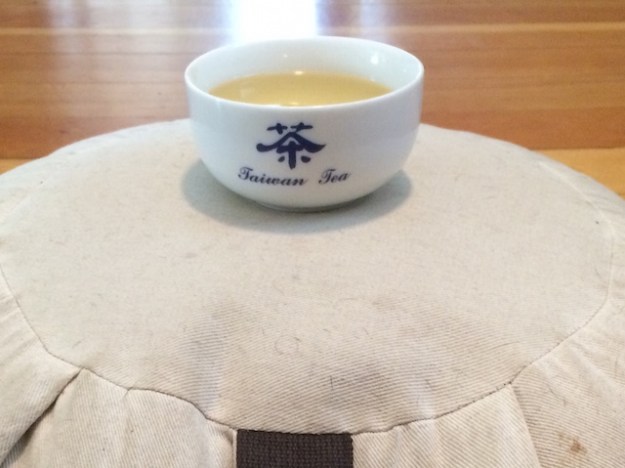Last weekend I gathered some friends together to get to know a handful of my Shēng (生, raw) Puer. I confess that most of the time I drink Puer I go for my favorite Shóu (熟, ripe) cakes. The deep, earthy flavors are very comforting and they tend to pack less of a punch. Also, many of my Sheng cakes are either too young to be tasty yet or expensive enough that I often think I’m saving them for a special occasion. It was easier, therefore, to create a special occasion just for them!
After a lot of discussion we picked four teas that were different enough that we hoped would give us a good range of tastes. A 2007 Yiwu, a 2007 Yinzhu factory bing, a 2009 Nanuo Shan, and a 2013 Yibang rounded out the circle.
The Yiwu was the darkest infusion of the four (9g each, with one rinse and then a 30 second steep) and had the largest, darkest leaves. The first infusion ended up with a fruity, cherry-like taste and a very interesting aftertaste-feeling that we could only describe as “minty”.
The Yinzhu was something of a mystery tea because while I know where I bought it (Dàlǐ Old Town in Yúnnán), I don’t know where the leaves were grown. The first infusion of this interesting tea had the second darkest liquor with small, orange tippy leaves. The flavor was very surprisingly rich with a smoky, oak and peat aroma, very like some of my favorite scotch.
Nannuo is one of my favorite tea mountains, so I had high expectations for this 2009 bing. The leaves were wiry and long, and with a light gold infusion. The flavor was a little sweet like strawberries, with a woody, cedar aroma. Overall, it had almost the quintessential Sheng flavor.
The 2013 Yibang was the youngest of the lot and so it’s not surprising that it had the lightest liquor. Its medium size leaves were dark brown speckled with blond. Using the same steeping time was probably unfair for this tea, and it tasted a little under-infused with not much body and a light mineral bite.
For the second infusion I brewed each tea for 45 seconds, partially by accident, and partially to see how the flavors would develop if they were made really strong. (This is a good point to mention that if you have never made Puer yourself, 45 seconds for a second infusion is quite long.) The result? Bitter tea, of course. But the comparison was pretty fascinating as it emphasized the characteristics I found during the other infusions. The Yiwu was very herbal, the Yinzhu gave the impression of a charcoal baked potato. The Nannuo tasted like mushrooms, and the young Yibang was bright and acidic.
At the third infusion (10 seconds this time), I think each tea hit its stride. The Yiwu created a cooling, refreshingly minty feeling with a herb and cherry taste. The mysterious Yinzhu made us all think of cacao nibs, with a warm scotch peat aftertaste. Our Nannuo leaves had a woody, mouth-filling texture and a smooth, crisp Bartlett pear taste. FInally, the 2013 Yibang tasted a little like a woody green tea with a long, second sweetness in the throat.
All in all most of the consensus was that the Yinzhu was the best of the bunch, but that’s just because most of us liked scotch. The dissenting opinion was in favor of the Yiwu, and indeed the unique mouth feel of that tea was both unexpected and fantastic. We all agreed that the Yibang was too young (although it definitely has promise) and that the Nannuo was a good sipping Sheng but didn’t stand out from the crowd.
I’m very happy to have had the opportunity to taste these teas side-by-side with friends and I think it’s setting me on a good path to get to know my Shengs. I have a whole lot more cakes, though, so next time promises to be just as exciting. If you have never tasted different teas together, I highly recommend it. If you drink a single tea one day and then another the next day, it’s very difficult to get a sense of what sets them apart. So grab those gaiwans (or tasting sets) and get brewing!

































































